From 2002 onwards Rally Finland has had only one service park in Paviljonki. Essentially this created the format of WRC events as we know them today. The routes remained quite similar during these years with new stages becoming rare. The era of very long stages also ends here.
Cover photo by Vas Foto [CC BY-SA 4.0]
2002-2006 – The birth of the modern WRC format
In 2002 all servicing of Rally Finland was centered to Paviljonki. The area became a good spectator attraction as well since the service crews stayed there all weekend and the cars returned multiple times a day. However, this meant more liaisons for the drivers. The competitive length was now 401 km and the road sections 1301 km long.
In addition, the competitive distances between services grew longer. In 1994 there was still free service between almost every stage, now eight years later there were always at least two stages and 40-60 km of racing between services (except for super specials).
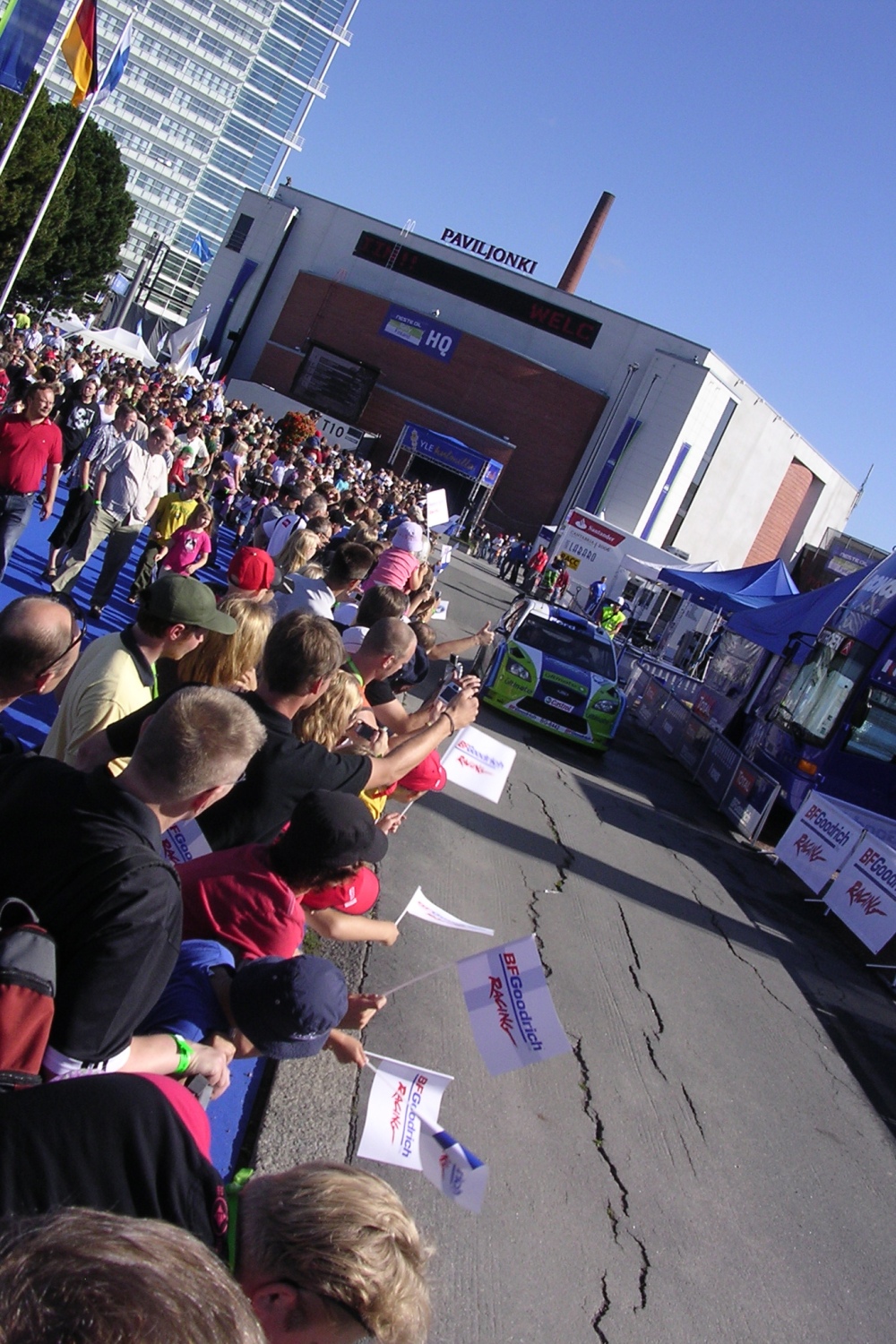
2002 introduced the concept of starting the rally with the Killeri super special on the Thursday evening, with a repeat to conclude the Friday night. This together with the single service park essentially created the format of today’s WRC events, with just a couple of parameters tweaked on the way, such as overall length and the amount of single-run stages.
Killeri would hold a monopoly by being the only super special driven in the rally throughout the decade, whereas in the previous years various spectator stages had come and gone. The current clerk of the course Kai Tarkiainen explains this: “Building proper VIP services is expensive, so it’s not reasonable to spread them all over”. As we remember, at the time the event started becoming true to its slogan, more than a rally.
Another change was that the rally was now arranged already at the second weekend of August. This was roughly two weeks earlier than traditionally, although it’s worth noting that in the early 70’s the rally was also driven in the beginning of August.
The routes from 2002 to 2006 are very similar with each other. For all of them it was Friday with stages North-West and North-East from Jyväskylä, Saturday further in the South-West and Sunday in the West. The route consisted now of ten individual loops from Paviljonki.

The 2002 Friday stages were almost same as the year before. In fact, the only change was that Ruuhimäki was again back on the itinerary, replacing the second run of Valkola. However, the ending of Ruuhimäki was extended on smaller roads. Meanwhile, Laajavuori took the shakedown job.

The ending of the Laukaa stage was shortened. At the same time, the infamous Lossimutka was modified to be a long bend instead of a 90° junction. It is shown here at 8:45
The Saturday leg was compressed to a tighter area and schedule, meaning longer stages. Most of the stages were familiar from the year before. Talviainen was reversed and had a small bit of new road at the end, whil Ehikki had its small road loop in the middle removed. Additionally, the second run of Ouninpohja ended again before the small road section like in 2001.
Vaheri – Himos was a new combination of mostly familiar roads. It started with the 31 km of the Vaheri stage last driven in 1999. After that the 1991 Himos stage route in reverse was used to go to the skiing center. Finally this 35 km monster of a stage was completed by a partial run through the purpose-built twin-car Himos stage.
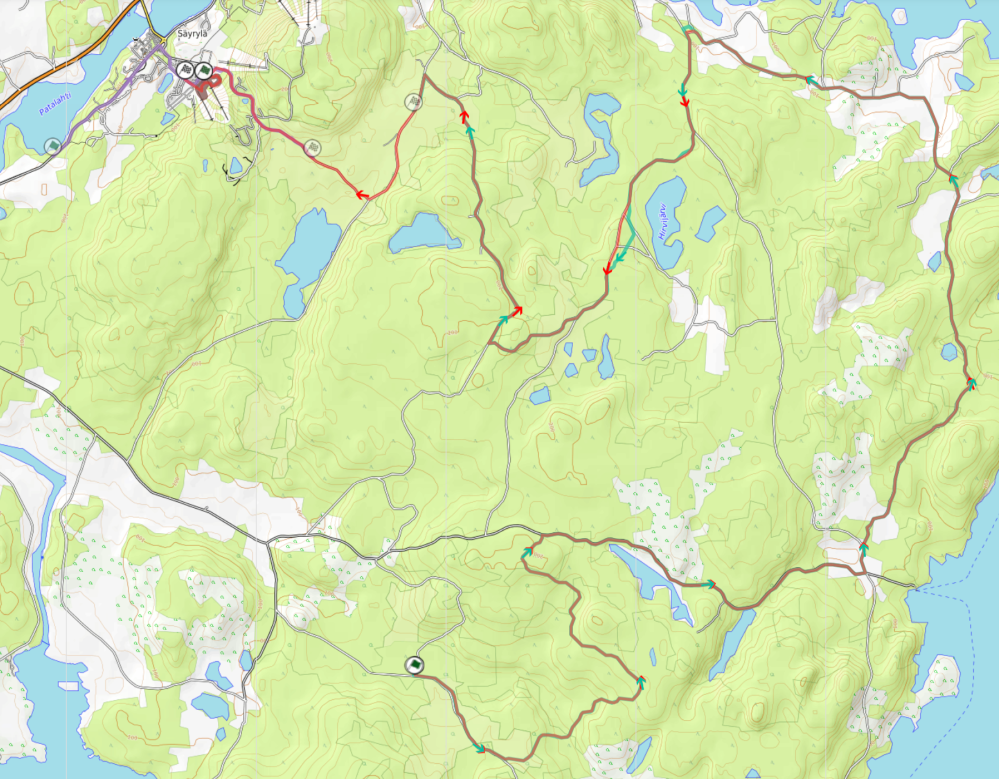
The Sunday stages were now driven to the West of Jyväskylä. The Keuruu and Jukojärvi stages made a comeback after some years of absence. Keuruu had one short section paved since last time and became the fastest stage of the rally at 132 km/h. The tarmac section can be seen at 2:11 on this onboard.
The rally was concluded with a brand new Kruununperä stage. A live TV broadcast showing the ending of the stage can be seen here
The year 2003 didn’t introduce any new stages. Now Friday had double runs on Jukojärvi and revised Kruununperä, in the morning and the evening.
In between, the Noth-Eastern loop was driven only once. Valkola, Lankamaa, Laukaa and Ruuhimäki formed a sort of quarter-circle on the North-East side of Jyväskylä. In fact, at least three of these four stages were driven back-to-back in the rally every year from 1998 to 2007 and in 1996. Ruuhimäki was shortened but still had half of the new parts added the year before, with the ending of the stage shown briefly in the helicopter footage at 10:05
Talviainen was now dropped from the Saturday route. It was replaced by Päijälä with a new route using the small roads from the 90’s but the ending from 2001.

The beginning of Ouninpohja was shortened to start after the Hämepohja junction, like it has almost always been afterwards. The stage was also repeated again in its full length.
However, Urria made a welcome return after 15 years. The route was the same as in 1986 but with a short small road section at the end. The stage can be seen on this 2007 onboard.
Vaheri – Himos was reduced to being just Himos with all of the classic Vaheri roads dropped altogether. Instead, a new forest road was added to the beginning, although it had been driven into the opposite direction in 1987 as a part of Vaheri 1.

Sunday was again driven West of Jyväskylä but this time staying closer to the city. Mökkiperä and Palsankylä were driven on Friday the year before, but Kuohu and Parkkola had taken years off the rally.
Mökkiperä was the last one of the rally, with its new ending. This also makes it nine years in a row with a different stage closing the rally (Hauhanpohja, Jukojärvi, Laukaa, Ylemmäinen, Ruuhimäki, Vaheri, Ouninpohja, Kruununperä and Mökkiperä).

The 2003 rally had again almost half of its stages single-run, whereas most years in this era had only about a third. This time Kruununperä was the fastest one in the rally, thanks to its new fast beginning with an average speed as high as 133 km/h. In addition to that Ehikki was marginally over 130 km/h and Ouninpohja over 128 km/h, but no other forest stage was faster than 125.5 km/h.
The 2004 route swapped again the Friday and Sunday double loops in the West like in 2002. Parkkola was shortened to end where it started in 1998. It’s the last time the stage has featured in the rally, although all of the roads have been used as parts of other stages.
The only change on Saturday was Vaheri returning onto the route, replacing Päijälä, also with yet another different route. It started like in 1989 and ended on a never-before driven forest road.

Ehikki was shortened from its fast forest road section in the beginning. Meanwhile, Himos had again a slightly shortened route, shown on this onboard. The skiing center Mickey Mouse section is joined at 5:35.
Jukojärvi and Kruununperä were now again the final stages of the rally, like in 2002. However, Kruununperä had received a new ending which brought its average speed down.

By now all forest stages were faster than 120 km/h except for Ruuhimäki and Moksi-Leustu, and the latter only by fractions. Petter Solberg had also exceeded the 130 km/h limit on Ouninpohja, so something would have to be done.
2004 was also an exceptional year by not running a Thursday opening super special at all, instead having Killeri just at the end of Friday and Saturday. However, in 2005 it was again back to the Thursday opening super special.
For 2005 the regulations changed and the maximum competitive length of WRC events was dropped from 400 to 360 km. This didn’t show much in the 2005 Rally Finland itinerary. The basic structure of the route and the stage count remained where they were, but the stages became shorter on average.
The 2005 Friday route now started with the Eastern loop. After that a new 34 km stage called Vellipohja was introduced. It started on the same roads as different versions of Leustu and ended where Surkee and Parkkola had often ended. It also went through a section driven before on the Korpiaho stage – usually into the other direction – as well as a short tarmac part.
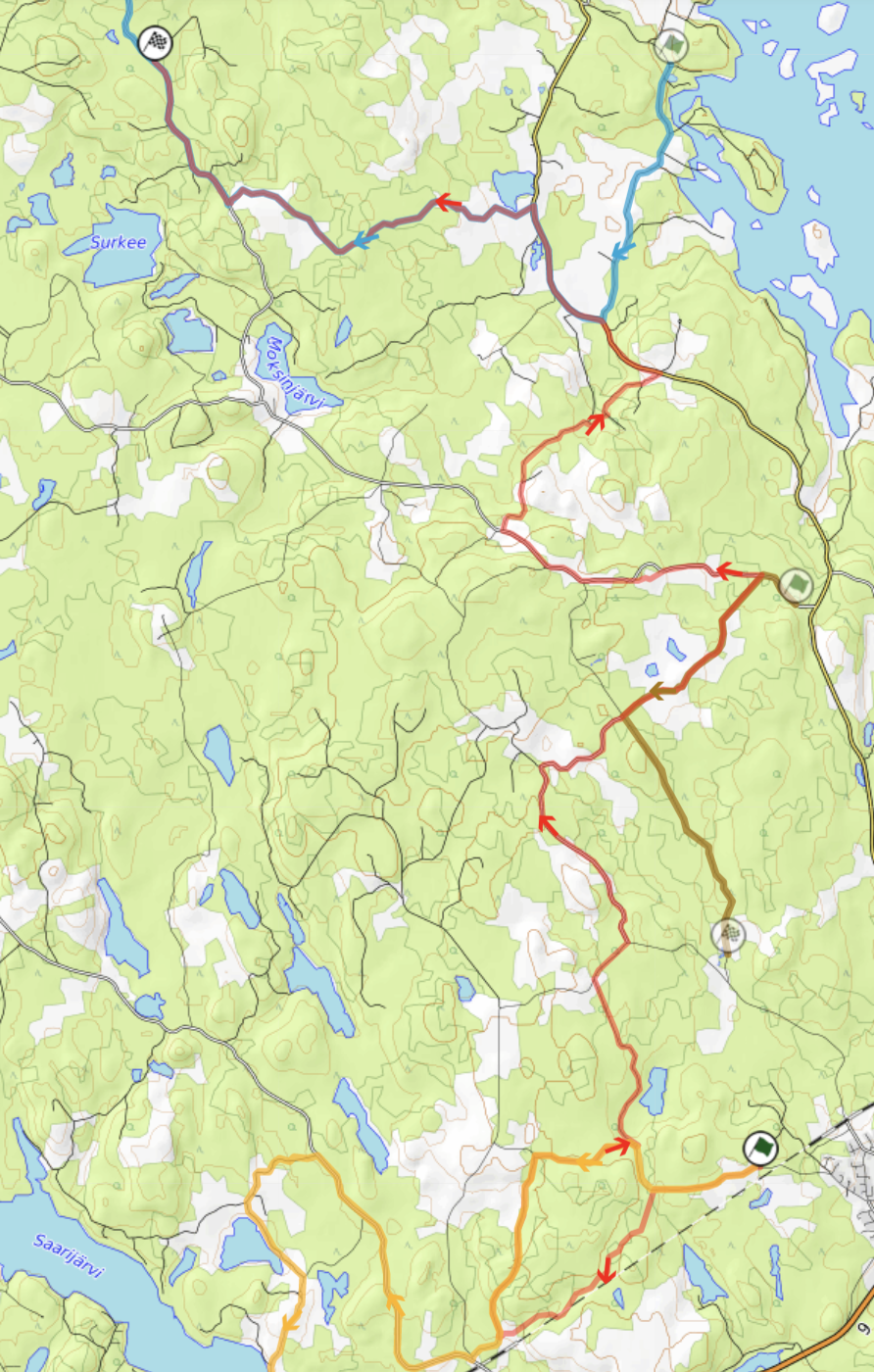
Ehikki might have been dropped for 2005, but the biggest change for Saturday was the splitting of Ouninpohja into two parts, Länsi and Itä, Finnish for West and East. The fastest part in the middle was now left out and the two parts would get an acceptable average speed, although the second run of the Western one would come close to being faster than 130 km/h.
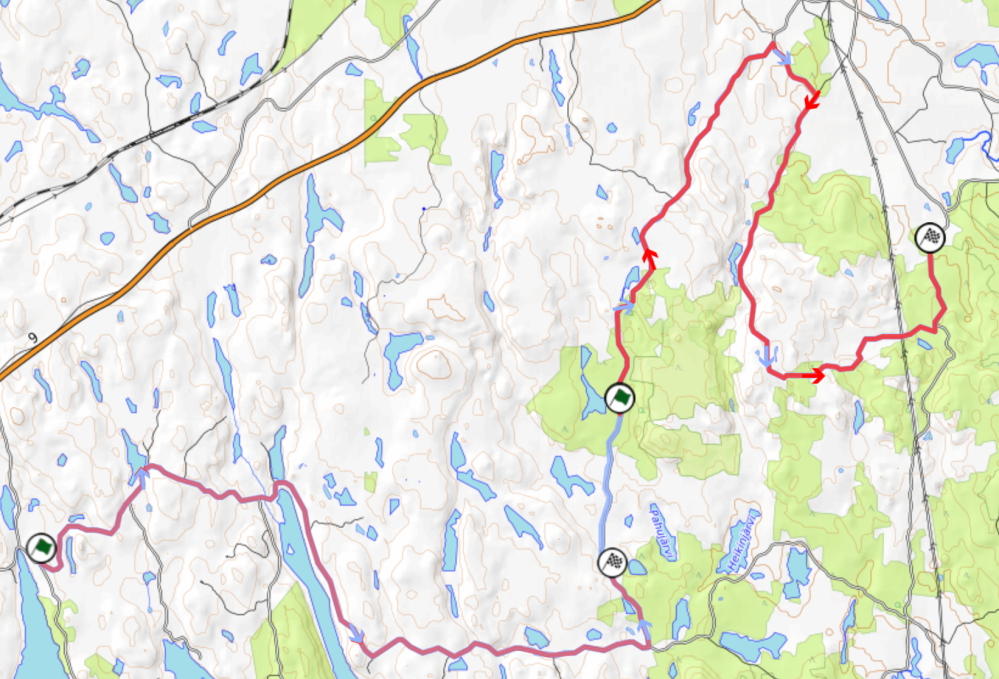
Vaheri also had again a new route, adding a piece of forest road never driven before, and then joining the Vaheri – Himos route all the way to the skiing center. The Himos stage driven on the evening was a partial repeat, starting on the aforementioned forest road, and adding the artificial track part (which was never driven on a stage called Vaheri).

Sunday consisted of two pairs of repeated stages. They were now driven without a service in the middle, being the first time there was no Sunday service at all – again, business as usual today.
It was again Kruununperä concluding the rally, paired this time with Kuohu. It can be seen on this onboard. The stage wouldn’t appear again after 2006.
The 2005 and 2006 routes are probably the two most similar ones ever in the history of the rally. The only changes for 2006 are a few kilometres added to the end of Vellipohja and some cut from the beginning of Mökkiperä (rumoredly thanks to misbehaving spectators) as well as Kruununperä being replaced by Jukojärvi as the last stage of the rally.
The era of marathon stages would end here. With the sole exception of Ouninpohja, there haven’t been any stages over 30 km in length after Moksi – Leustu and Vellipohja of 2006.
2007-2008 – Something new, something old
The 2006 rally had been driven exceptionally later in August, but in 2007 the event was again scheduled earlier than before. Now it would start on the first weekend of August, making it even more of a summer event than before.
After many years of driving the same stages, it was finally time for some updates. New stages weren’t easy to find, but dusting off old ones was as effective.
Friday was now driven completely in the West and Sunday in the East. This was the first time since 1999 that the rally operated on different compass points each day.
The Friday leg opener Vellipohja was shortened considerably from both ends. However, the ending now used the Pöykky road, familiar also from the Surkee and Parkkola stages.

Next up was Mökkiperä with a new beginning section. The third stage of the day was the returning Palsankylä in a shorter format. Its route can be seen on this video with the infamous big jump at 6:00.
After repeating the first stages, the third loop contained single runs, including Lautaperä, a reversed version of 1980’s Pohjoislahti. It became surprisingly fast at 132 km/h on the stage winner’s average speed.
The rule changes for 2007 permitted remote servicing again. Thus, Saturday contained a 15 minute remote service in Jämsä. This helped in shortening the liaison sections by roughly 150 km, but the teams weren’t too happy about the expensive solution.
The day commenced with the return of Kaipolanvuori. It used the 1996 Heräjärvi route in reverse direction with a brand new beginning section.

Talviainen was another stage to return for the first time since 2002. However, it was now again called Juupajoki. The direction was the same as in 2002, but the last fast section was removed.
Saturday gave a welcome return to the full-length Ouninpohja, being also now again the longest stage of the rally. However, it was slowed down by three chicanes. One chicane was also placed on Ehikki, its route now featuring no small roads, similarly as in 1988. The chicanes didn’t get much praise, and in the end the average speeds of these stages would be only fractionally below the limit of 130 km/h.
Himos was extended from its beginning. It used the same forest road as Vaheri in 2004, and a bit of the main road not used since 1987. Meanwhile, Vaheri itself was not used anymore in the rally.

Moksi – Leustu was now abandoned and replaced by a more traditional Leustu as well as another returning stage in the Moksi area, Surkee. The latter had a new route, becoming the slowest forest stage of the rally at 108 km/h. This video from 2009 shows the route, although the very first bit of road on the video was unique to 2009. Surkee would become a staple stage for the future editions of the rally.
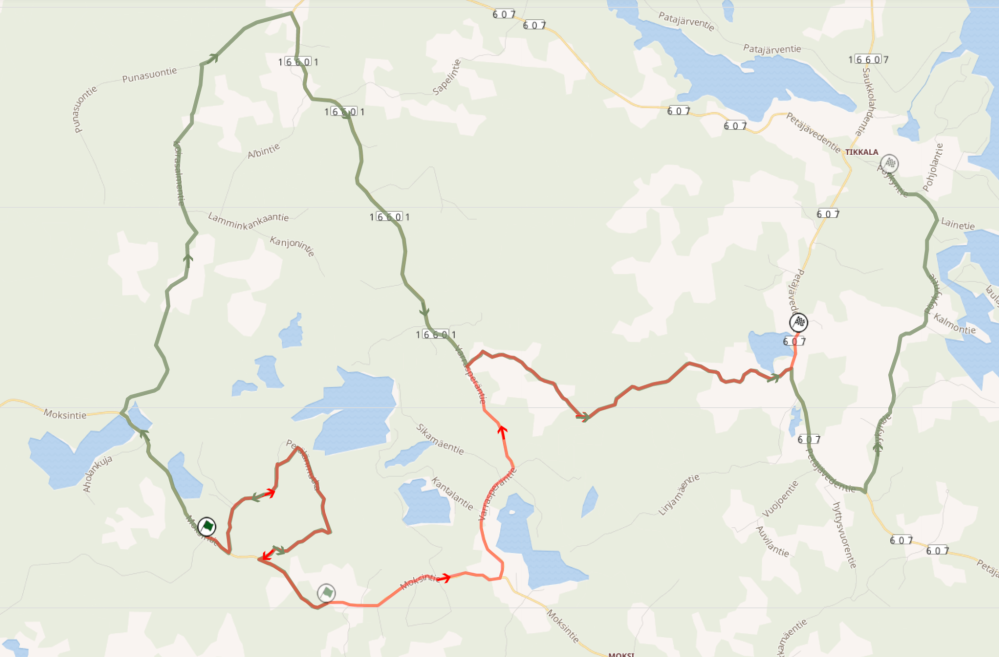
Sunday was now driven around Laukaa in the East. Having only three stages didn’t even feel like there was a need for a midday service anymore.
The day opener Valkola returned after two years off. It was reversed for the first time since 1996 in addition to having a new ending. However, this would be the last time that stage would be run in the rally.

Lankamaa had a new, faster ending for this occasion. However, this meant that the popular and crash-prone Latomutka was not included on the stage anymore.

The 2008 rally was still arranged on the same weekend, but because of the yearly moving of week numbers, the rally started now on the last days of July. This was the first time that the event was arranged during July.
The Friday route of 2008 had all same stages as in 2007, but some changes were made. Urria got a new beginning, making it now the fastest stage of the rally at 126 km/h.
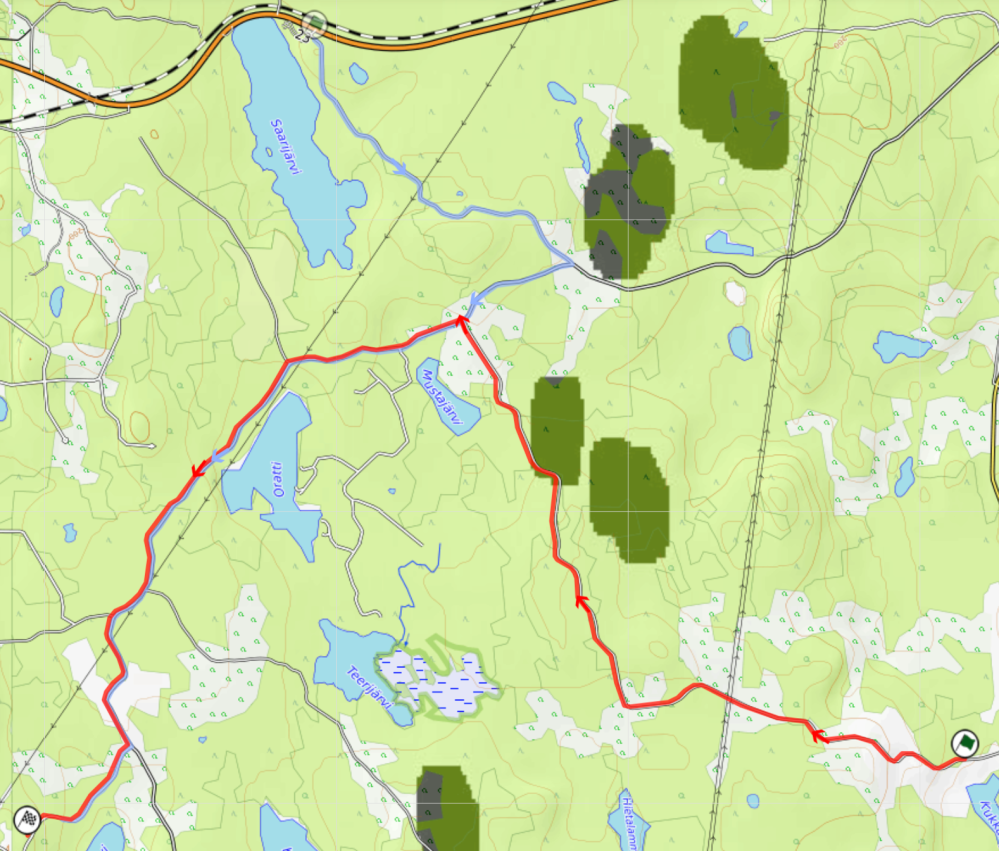
Conversely, the super fast Lautaperä was successfully slowed down with a new ending.

Saturday was shuffled more. Himos now opened the day with yet another new route, with the beginning on roads which were never used before or after this stage.

Hirvimäki is a new title, but for the most part it consisted of familiar forest roads from the Parkkola and Moksi – Leustu stages. It was driven again into the Parkkola direction and the beginning was new.

However, the biggest change was that there was no Ouninpohja. Instead, a new stage called Kakaristo was used, containing the Northmost part of Ouninpohja, reversed, finishing with a new small road section.

Both Kaipolanvuori and Juupajoki were reversed. Meanwhile, Väärinmaja returned after a break of 20 years. The classic route was prepended with some new forest roads in the beginning.

All these stage updates ensured that the Saturday was now slower than in a long time. In fact, all stages except Leustu had an average speed of less than 116.5 km/h.
The biggest change of Sunday was that Valkola was replaced with Hannula, returning from 1995. Its technical route with numerous junctions can be seen on this 2009 onboard video.
Ruuhimäki concluded the rally like the year before. However, now the finish was again already on the main road just like in 1999.
2008 was the slowest Rally Finland in ten years. We could address it to the fact that the long-time winner Marcus Grönholm was not competing anymore, but the 117 km/h winning pace of Sebastien Loeb would have set him back 7 minutes in 2007, so it’s quite clear the route was much slower now. The current deputy clerk of the course Kari Nuutinen also reminds that the rainy weather put its strain on the condition of the roads.
It’s also remarkable that the routes of 2007 and 2008 had half of the stages run once, which is already more than the previous years in this era have offered. Lankamaa was the longest stage of the rally at just 23 km, this being almost reminiscent of the sprint nature of the rally in the mid-80’s.
The average stage length had peaked in 2001 at 19.35 km, but since then it started to decrease year by year. In 2008 it had come down to 14.18 km, exactly the same as in 1992 with every year in between higher than that. Conversely, the 2008 stage count of 24 was the highest in ten years.
2009 – Towards the modern era
In 2009 the rules had brought the maximum competitive length of a rally back up to 400 km. However, the 2009 Rally Finland route was considerably shorter than allowed, at 345 km. Meanwhile, the average stage length was slightly higher than the year before.
The structure of Friday was changed to two loops of four stages instead of three loops of three stages – much like today. Vellipohja was dropped in favour of Kruununperä, with a much revised route, sharing some bits with 2005 and 2002, and even them reversed.

Saturday used still the three-loop structure like before. The two first loops were identical to each other. Himos had now a route similar to Vaheri in 2005, with the Mickey Mouse section added to the end.
The evening run was again towards Juupajoki with the returning Kavala in place of the Juupajoki stage. However, Kavala shared nothing with the similarly titled stage run in 1986-1987. The new stage also ended on a rallycross track.
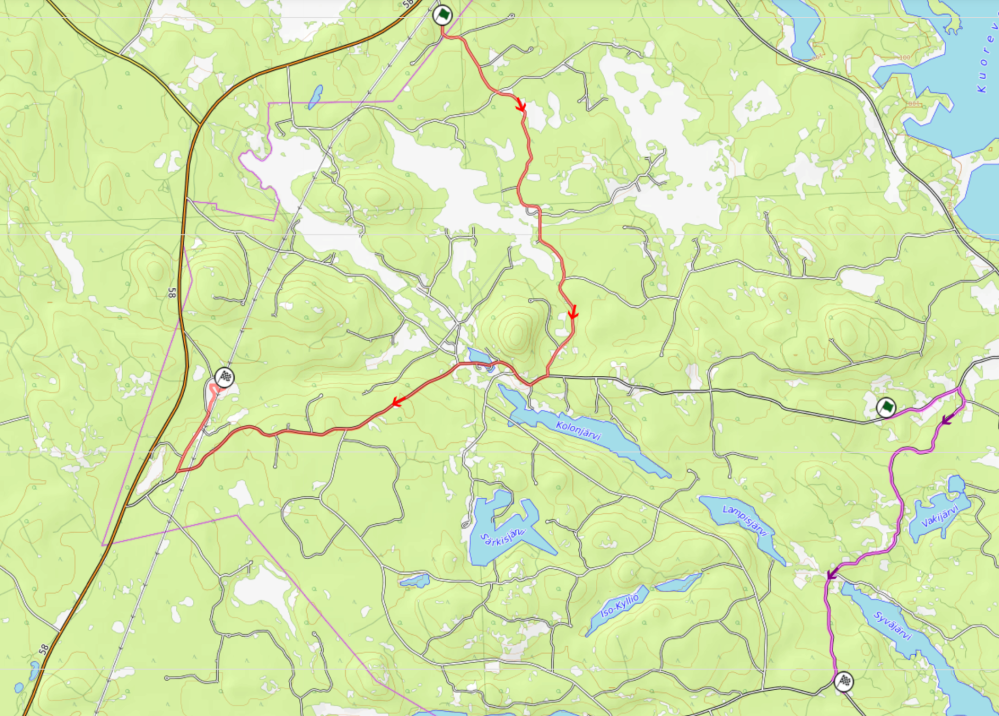
At the same time, Väärinmaja got more length in the beginning from a mix of small and wide roads. This way it became the longest stage of the rally at 29 km.
However, it’s notable that Ouninpohja was again missing from the Saturday itinerary. Not even any parts of the stage were driven for the first time since 1976.
On Sunday, Lankamaa was replaced by Myhinpää, returning for the first time since 1995. It was driven twice consecutively in the middle of the day, being the first time that a forest stage has done so. Myhinpää was also quite expectedly the fastest stage of the rally with 131 km/h of average speed on the second run.
In 2009 only five of the stages were run once, being the lowest number of single-runs so far in the rally. However, things wouldn’t really improve on this aspect in the future.
| Year | Stages | Stages total length | Avg stage length | Winner avg speed | Fastest stage | Longest stage | ||
| 2001 | 21 | 406.38 km | 19.35 km | 119.99 km\h | Ouninpohja | 128.94 km\h | Moksi-Leustu | 40.84 km |
| 2002 | 22 | 401.68 km | 18.26 km | 121.80 km\h | Keuruu | 132.38 km\h | Moksi-Leustu | 40.84 km |
| 2003 | 23 | 409.18 km | 17.79 km | 121.62 km\h | Kruununperä | 133.72 km\h | Moksi-Leustu | 40.96 km |
| 2004 | 22 | 382.71 km | 17.40 km | 114.51 km\h | Ouninpohja | 130.28 km\h | Moksi-Leustu | 40.96 km |
| 2005 | 21 | 355.59 km | 16.93 km | 122.49 km\h | Ouninpohja Länsi | 129.54 km\h | Moksi-Leustu | 40.96 km |
| 2006 | 21 | 351.61 km | 16.74 km | 122.06 km\h | Ouninpohja Länsi | 128.81 km\h | Moksi-Leustu | 40.96 km |
| 2007 | 23 | 360.34 km | 15.67 km | 121.85 km\h | Lautaperä | 132.32 km\h | Ouninpohja | 33.01 km |
| 2008 | 24 | 340.42 km | 14.18 km | 117.32 km\h | Urria | 126.32 km\h | Lankamaa | 23.09 km |
| 2009 | 23 | 345.15 km | 15.01 km | 121.33 km\h | Myhinpää | 131.56 km\h | Väärinmaja | 29.29 km |
Longest stages in Finnish WRC events:
| Stage | Years | Length | |
| 1. | Kokkosenlahti | 1973 | 42.80 km |
| 2. | Risulahti | 1976 | 41.30 km |
| 3. | Moksi-Leustu | 2001-2005 | 40.96 km |
| 4. | Kokkosenlahti | 1974 | 38.40 km |
| 5. | Surkee | 1994-1995 | 37.31 km |
| 6. | Vellipohja | 2006 | 36.39 km |
| 8. | Hassi | 1993 | 36.27 km |
| 8. | Vaheri – Himos | 2003 | 35.83 km |
| 9. | Kokkosenlahti | 1975-1977 | 35.80 km |
| 10. | Ouninpohja | 1998 | 34.55 km |
Amount of single-run and repeated stages 1994-2009

Stages run every year 2002-2009:
- Laajavuori (as a shakedown every year)
- Killeri
- Mökkiperä
- Ruuhimäki
- Himos (Vaheri – Himos in 2002)
- Leustu (Moksi – Leustu from 2002-2005)
<< Rally Finland Route History IV: 1996-2001
<< Rally Finland Route History III: 1988-1995
<< Rally Finland Route History II:1982-1987
<< Rally Finland Route History I: 1973-1981